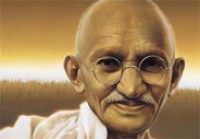Keeping the Mahatma¿s ideals alive

Mahatma Gandhi said: "The sole aim of journalism should be service. The newspaper is a great power, but just as an unchained torrent of water submerges the whole countryside and devastates crops, so an uncontrolled pen serves, but, to destroy. If the control is from without, it proves more poisonous than want of control. It can be profitable only when exercised from within." Going by this line of reasoning, how many publications in the world today would be able to measure up?
While Gandhi tried to uphold these ideals when he published "Young India" and "Harijan," they seem completely out of sync with today¿s consumerist generation dominated by the corporate media.
However, a group of more than 30 teenagers from across India is trying to live up to the ideals of their beloved Bapu through their work on "The Yamuna," a newspaper presented by Gandhi Smriti. The paper was launched in 2007 as part of the Gandhi Media Literacy Programme initiated by Gandhi Smriti.
The group writes stories of social relevance when they don¿t have exams.
Commenting on the large number of girls on the journal¿s editorial team, Veda Vyas Kundu, a member of Gandhi Smriti and the coordinator of the newspaper, says, "We experience reverse gender discrimination here. Most of the team members are girls."
The editor of the current issue, Rijuta Lamba, adds, "I don¿t know why there haven¿t been many boys in this venture. Probably they don¿t find it interesting."
Gandhi Smriti members go to schools and handpick students for the publication¿s team. "We work with several schools all over the country as a part of the Gandhi Media Literacy Programme. That way we are able to scout for students," says Kundu.
He explains: "The goal of the Literacy Programme is to develop in children a critical understanding and functioning of the media. Media production is also an important process in which we encourage the children to participate. We go and talk about the newspaper to students. There is no sifting process. Every applicant is selected. But there are many who drop out midway. In the end only those who are interested stay on."
The newspaper¿s printing schedule is set according to the students¿ examination schedules. The number of pages in each issue ranges between 16 and 20 and include opinions, interesting features, lively interviews and colourful caricatures and cartoon strips.
Even though the children have varied and contemporary interests, the coverage of various social issues is governed by a sound understanding of good and bad journalism. Surprisingly not many want to pursue a career in journalism. Lamba is no exception. "I want to specialise in science. I am not looking at being a media professional. I am just not interested in the profession," she says.
The students keep in touch through e-mail. The story ideas are decided democratically through debates and discussions. Where e-mails cannot be sent or accessed, Gandhi Smriti coordinators become the messengers.
The students have developed a keen sense of news along with an idea of what can or cannot be termed responsible journalism. Recently, "The Yamuna" team members met with India TV CEO Rajat Sharma and talked to him about various issues including the business of news, social responsibility of the media, and his channel.
The youngsters captured their interaction with Sharma in the article "Of Sense and Sensationalism" published in the September 2008 issue. Tackling the issue of sensationalism, the article noted: "... there is one thing for sure that these channels are aiming at — to be at the top."
"This is a business, which has to cater to the needs of people," Sharma was quoted as saying. "We as mediapersons are not involved in preaching. This is not our job. But we show such things, which has an impact on society."
The September issue also tried to figure out what children like to watch on television. A survey conducted by children in several cities including New Delhi, Hyderabad, Guwahati, Solan and Bikaner was presented. The sample size in every city ranged from 30-150. The survey concentrated on the media usage habits of children spread across many cities in India.
The girls expressed a critical opinion of the "saas-bahu" daily soaps. Himanshi Diwan, a student at Delhi¿s Presentation Convent, says, "I don¿t understand the ¿saas-bahu¿ serials. The stories are always about people with a lot of money. But what about the middle class?"
Another team member says with a laugh, "Women don¿t sleep with so much makeup on."
Lamba adds: "The women in such serials always go back to the men even after being treated with disrespect all the time. Why do they show that? Why will a woman do anything like that?"
There won¿t be a special issue for Children¿s Day on November 14 because of the forthcoming exams — year-end and pre-boards — with the next edition of "The Yamuna" slated for January 2009. It will tackle the issue of multiculturalism. "It will be about multiculturalism and identity in India. The children wanted to explore this in the light of the violent incidents in Maharashtra caused by the Maharashtra Navnirman Sena," Lamba says.